Avoid getting scammed by sites claiming "You have (1) package waiting"
Phishing/ScamAlso Known As: You have (1) package waiting pop-up
Get free scan and check if your device is infected.
Remove it nowTo use full-featured product, you have to purchase a license for Combo Cleaner. Seven days free trial available. Combo Cleaner is owned and operated by RCS LT, the parent company of PCRisk.com.
What is "You have (1) package waiting"?
"You have (1) package waiting" is a scam run by deceptive websites. Under the guise of an official delivery tracking site, the scam claims that visitors have packages waiting for them. The purpose of this scheme is to trick users into making a monetary transaction, a fake delivery fee.
All information provided by this scam is deceptive and there is no package for collection. Making any payments will not allow users to receive any deliveries. These deceptive/scam websites are usually accessed via redirects caused by intrusive ads or Potentially Unwanted Applications (PUAs) already present on the system.
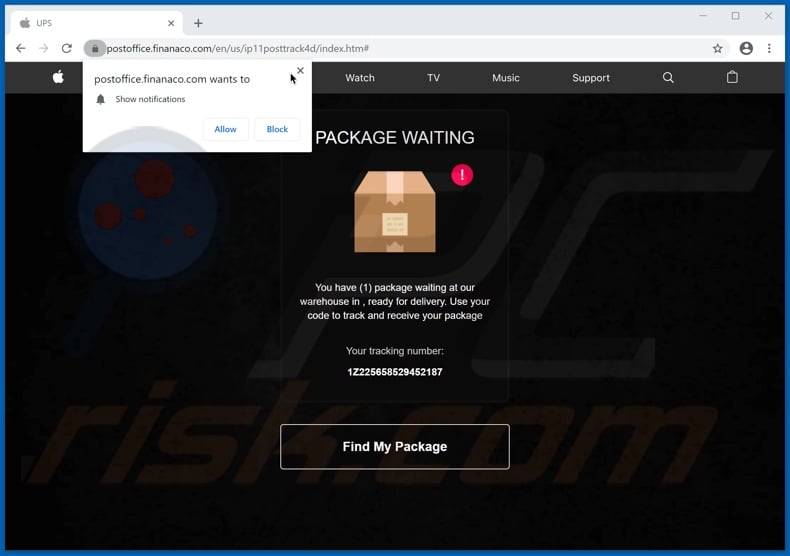
"You have (1) package waiting" scam overview
There are several (virtually identical) variants of the "You have (1) package waiting" scam. The scheme states that the visitor's package has been prepared and is waiting for shipment at the warehouse. It instructs people to use the tracking number (presented on the site) to schedule delivery. After the "Find My Package" button is clicked, a different page is loaded.
This lists the package details such as status, delivery service, content and shipping address. In one variant of the scam, the package allegedly contains an iPhone 11 and will be delivered by the UPS delivery company. In another, a Samsung S10 with Canada Post responsible for delivery.
In both versions, the shipping fee is blank. Clicking "Schedule My Delivery Now" leads through several pages, surveying users regarding delivery details. Firstly, it questions whether users prefer to receive the package at home or at work, and then whether on a weekday or weekend.
Following this brief questionnaire, users are asked to confirm delivery with the expected arrival time being between three to five days. It instructs users to provide their contact information and pay the shipping on the next page. When the "Get My Package" button is clicked, it redirects to a different site, through which users can make this transaction.
At the time of research, the website to which the "You have (1) package waiting" redirected was broken. You are strongly advised against trusting this scam, as doing so will lead to financial loss. Furthermore, any information revealed to the scammers (e.g. identity, workplace and/or home address, banking account and/or credit card details, etc.) will be stolen and misused.
PUAs can force-open various deceptive, rogue, sale-oriented, compromised and even malicious sites, however, they also have other capabilities. Some can deliver intrusive ads, which diminish the browsing experience, redirect to harmful web pages and stealthily download/install rogue content (e.g. PUAs).
Other types can make unauthorized changes to browsers, restrict/deny access to their settings and promote fake search engines. Most PUAs (regardless of the specifics) can track data, with information of interest including (but not limited to) URLs visited, pages viewed, search queries typed, IP address, geolocations and users' other details.
This private data is then shared with third parties seeking to misuse it for profit - possibly, by putting it to criminal use.
In summary, PUAs can cause browser/system infiltration and infections, lead to financial loss, serious privacy issues and even identity theft. To protect device integrity and ensure user safety, remove all dubious applications and/or browser extensions/plug-ins without delay.
| Name | You have (1) package waiting pop-up |
| Threat Type | Phishing, Scam, Social Engineering, Fraud. |
| Fake Claim | Scam claims visitors have a package waiting for delivery. |
| Related Domains | finanaco[.]com |
| Serving IP Address (finanaco[.]com) | 192.64.119.87 |
| Symptoms | Fake error messages, fake system warnings, pop-up errors, hoax computer scan. |
| Distribution methods | Compromised websites, rogue online pop-up ads, potentially unwanted applications. |
| Damage | Loss of sensitive private information, monetary loss, identity theft, possible malware infections. |
| Malware Removal (Windows) |
To eliminate possible malware infections, scan your computer with legitimate antivirus software. Our security researchers recommend using Combo Cleaner. Download Combo CleanerTo use full-featured product, you have to purchase a license for Combo Cleaner. 7 days free trial available. Combo Cleaner is owned and operated by RCS LT, the parent company of PCRisk.com. |
Online scams in general
"Is this your package?" is a thematically identical to "You have (1) package waiting", "SPECIAL AWARD FROM OUR SPONSORS", "Get the new iPhone 11 Pro" and "Randomly selected to test the new iPhone" - just some examples of other scams.
Online scams are very common and use social engineering and scare tactics to encourage users into performing certain actions. Popular scam models are warnings that the device is at risk / infected, alerts that a crucial piece of software is outdated/missing, notifications of prizes won, "amazing" offers and so on.
They are used to trick people into downloading, installing, and purchasing nonoperational, untrustworthy or malicious content, calling expensive fake technical support lines, making monetary transactions, revealing personal/sensitive information, etc. The sole purpose of these schemes is to generate revenue for the scammers at users' expense.
How did potentially unwanted applications install on my computer?
PUAs can be downloaded/installed together with other programs. This deceptive marketing technique of pre-packing normal products with unwanted or malicious software is called "bundling". Rushing download/installation processes (e.g. ignoring terms, skipping steps, etc.) increases the risk of inadvertently allowing rogue content onto devices.
Some PUAs have "official" download pages, which in turn are commonly promoted by deceptive/scam sites. When clicked, intrusive advertisements can execute scripts designed to download/install PUAs without users' consent.
How to avoid installation of potentially unwanted applications
You are advised to research all content before download/installation. Use only official and verified download channels. Free file-hosting websites, P2P sharing networks (BitTorrent, eMule, Gnutella, etc.) and other third party downloaders are classed as untrustworthy and should be avoided.
Approach download and installation processes with caution. Read the terms, study all available options, use the "Custom/Advanced" settings and opt-out of additional apps, tools, features and so on. Intrusive ads typically seem legitimate and harmless, however, they redirect to dubious sites (e.g. gambling, pornography, adult-dating, etc.).
If you encounter ads/redirects of this type, check the system and immediately remove all suspicious applications and/or browser extensions/plug-ins. If your computer is already infected with PUAs, we recommend running a scan with Combo Cleaner Antivirus for Windows to automatically eliminate them.
Text presented in "You have (1) package waiting" scam's initial web page:
PACKAGE WAITING
You have (1) package waiting at our warehouse in , ready for delivery. Use your code to track and receive your package
Your tracking number:
1Z225658529452187
Find My Package
Screenshot of the second page:
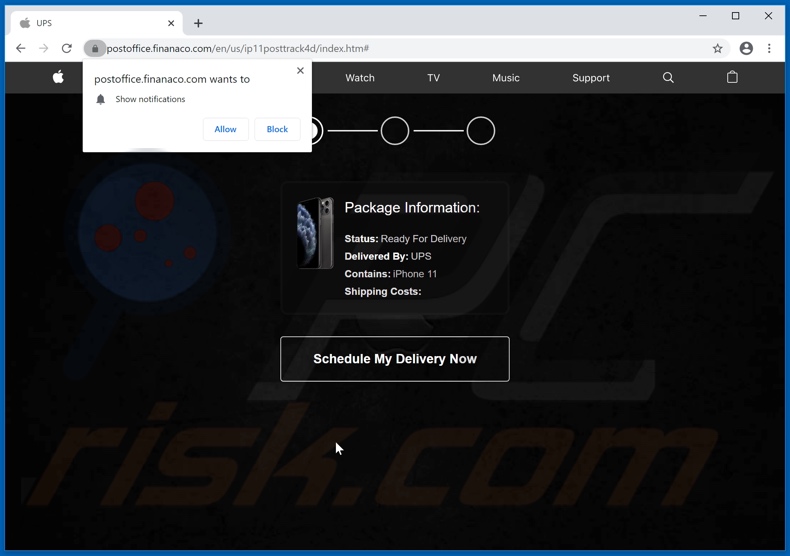
Text presented in this page:
Package Information:
Status:
Ready For Delivery
Delivered By:
UPS
Contains:
iPhone 11
Shipping Costs:
Schedule My Delivery Now
Screenshot of the third page:
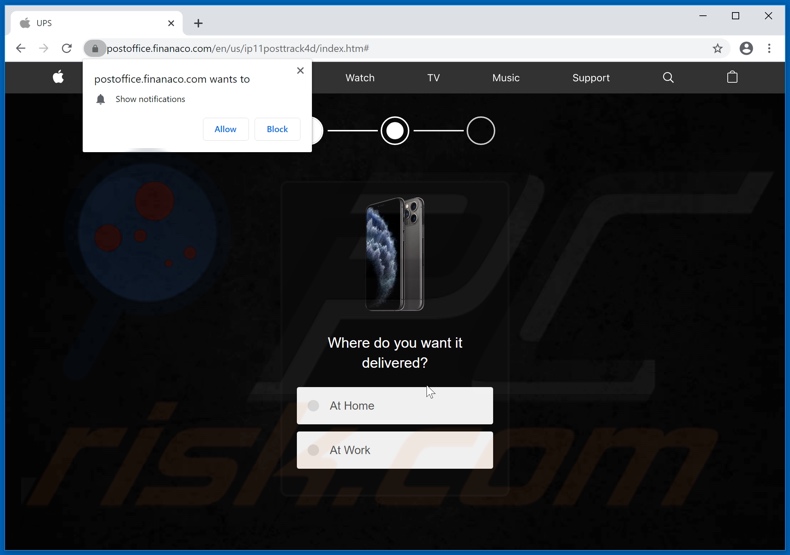
Text presented in this page:
Where do you want it delivered?
At Home
At Work
Screenshot of the fourth page:
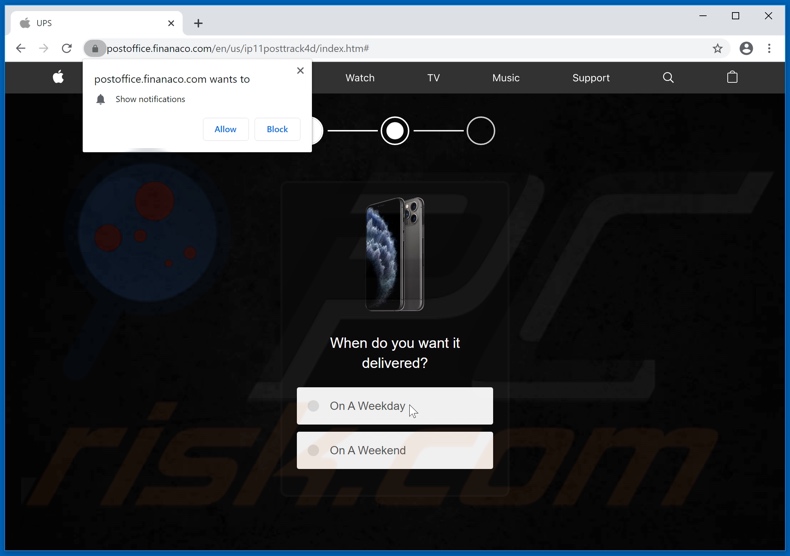
Text presented in this page:
When do you want it delivered?
On A Weekday
On A Weekend
Screenshot of the fifth page:
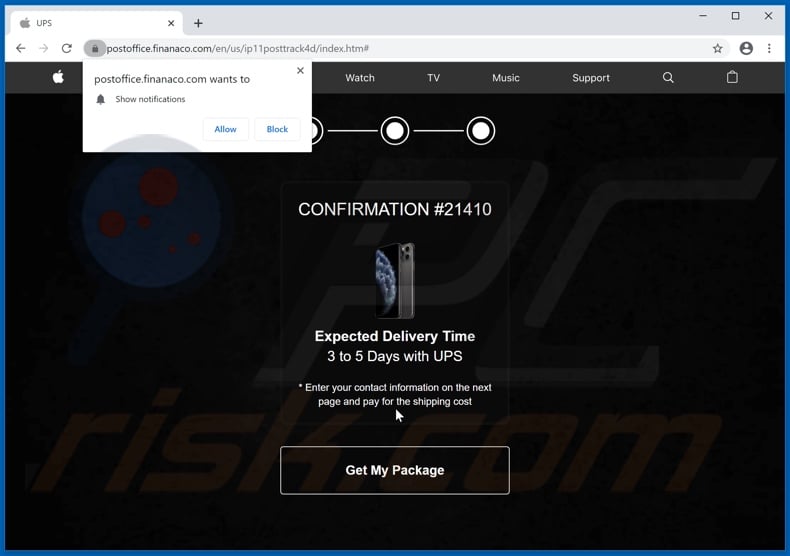
Text presented in this page:
CONFIRMATION #21410
Expected Delivery Time
3 to 5 Days with UPS
* Enter your contact information on the next page and pay for the shipping costGet My Package
The appearance of "You have (1) package waiting" scam (GIF):
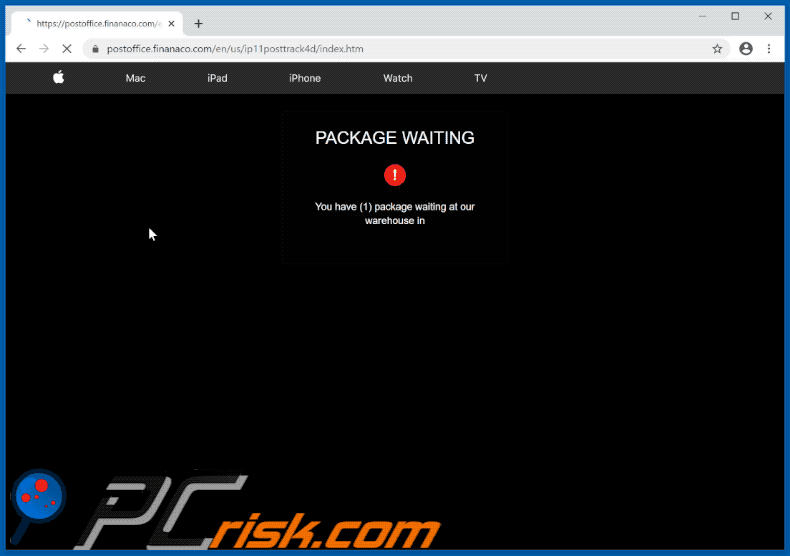
The appearance of the other variant of "You have (1) package waiting" scam (GIF):
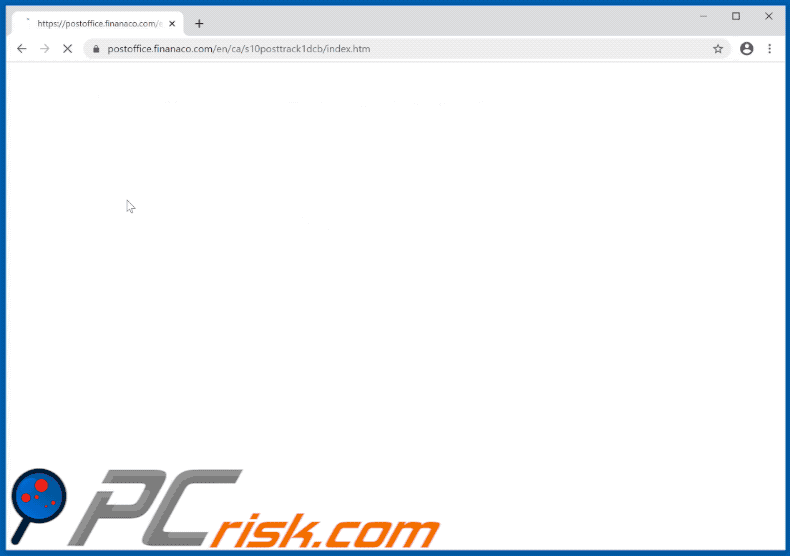
IMPORTANT NOTE! This deceptive site asks to enable web browser notifications (both scam variants).
Therefore, before commencing, perform these steps:
Google Chrome (PC):
- Click the Menu button (three dots) on the right upper corner of the screen
- Select "Settings", scroll down to the bottom and click "Advanced"
- Scroll down to the "Privacy and security" section, select "Content settings" and then "Notifications"
- Click three dots on the right hand side of each suspicious URL and click "Block" or "Remove" (if you click "Remove" and visit the malicious site once more, it will ask to enable notifications again)
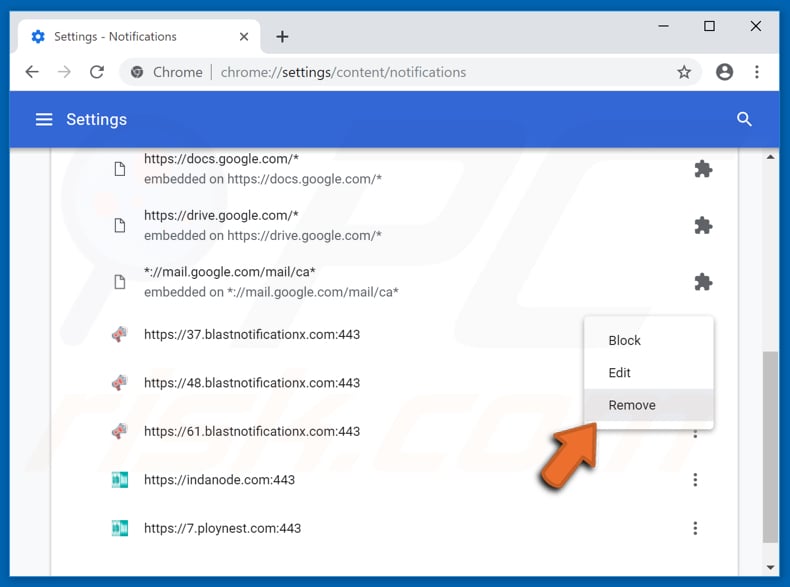
Google Chrome (Android):
- Click on the Menu button (three dots) on the right upper corner of the screen and click "Settings"
- Scroll down, click on "Site settings" and then "Notifications"
- In the opened window, locate all suspicious URLs and click on them one-by-one
- Select "Notifications" in the "Permissions" section and set the toggle button to "OFF"
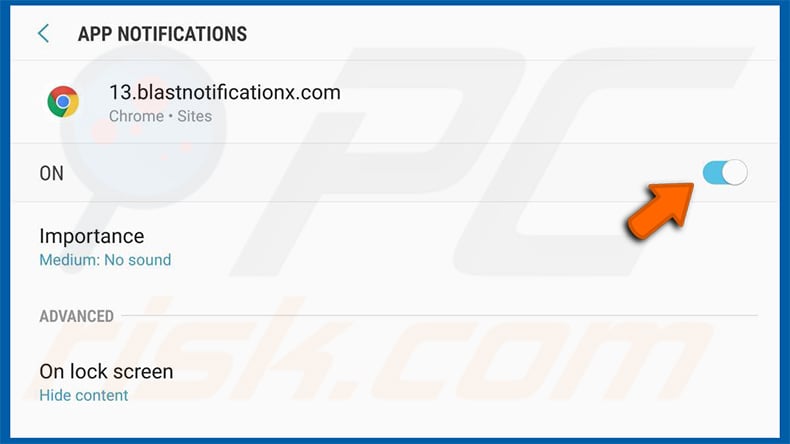
Mozilla Firefox:
- Click the Menu button (three bars) on the right upper corner of the screen
- Select "Options" and click on "Privacy & Security" in the toolbar on the left hand side of the screen
- Scroll down to the "Permissions" section and click the "Settings" button next to "Notifications"
- In the opened window, locate all suspicious URLs, click the drop-down menu and select "Block"
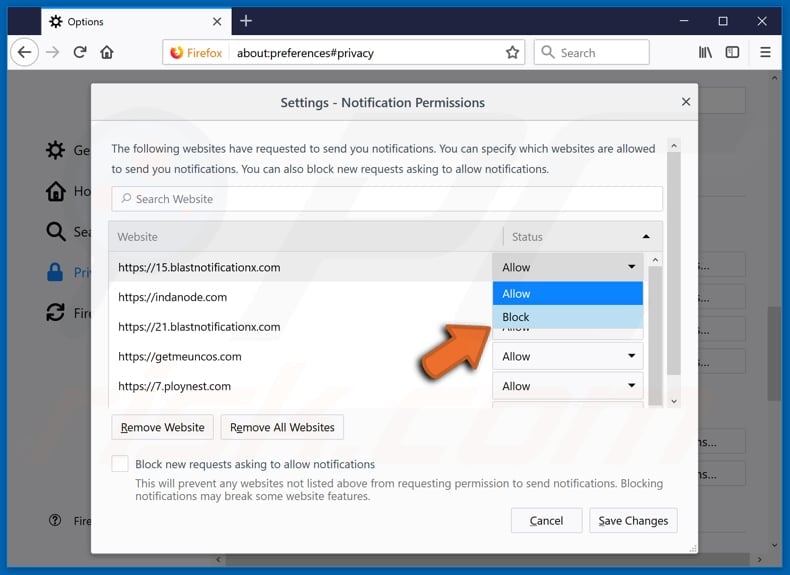
Internet Explorer:
- Click the Gear button on the right upper corner of the IE window
- Select "Internet options"
- Select the "Privacy" tab and click "Settings" under "Pop-up Blocker" section
- Select suspicious URLs under and remove them one by one by clicking the "Remove" button
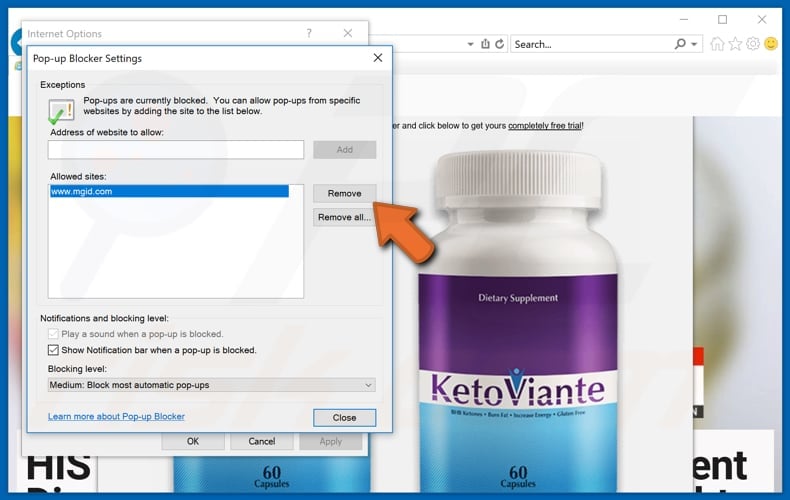
Microsoft Edge:
- Click the menu button (three dots) on the right upper corner of the Edge window
- Scroll down, find and click "Settings"
- Scroll down again and click "View advanced settings"
- Click "Manage" under "Website permissions"
- Click the switch under each suspicious website
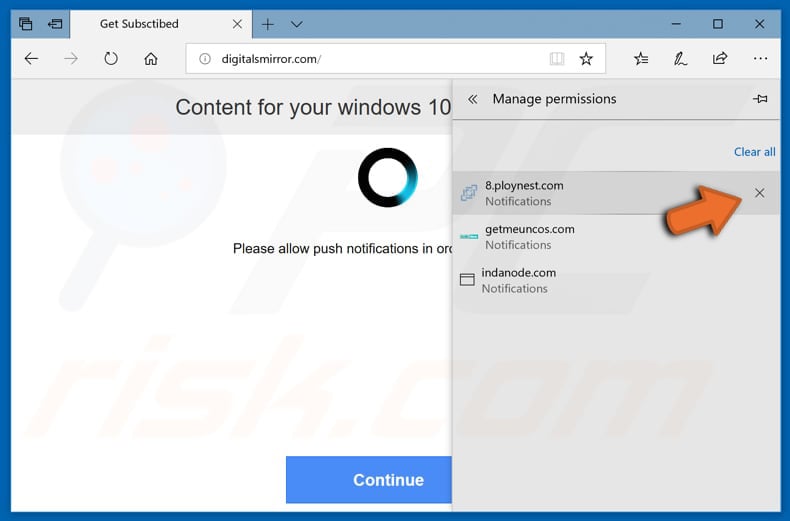
Safari (Mac):
- Click "Safari" button on the left upper corner of the screen and select "Preferences..."
- Select the "Websites" tab and then select "Notifications" section on the left pane
- Check for suspicious URLs and apply the "Deny" option for each
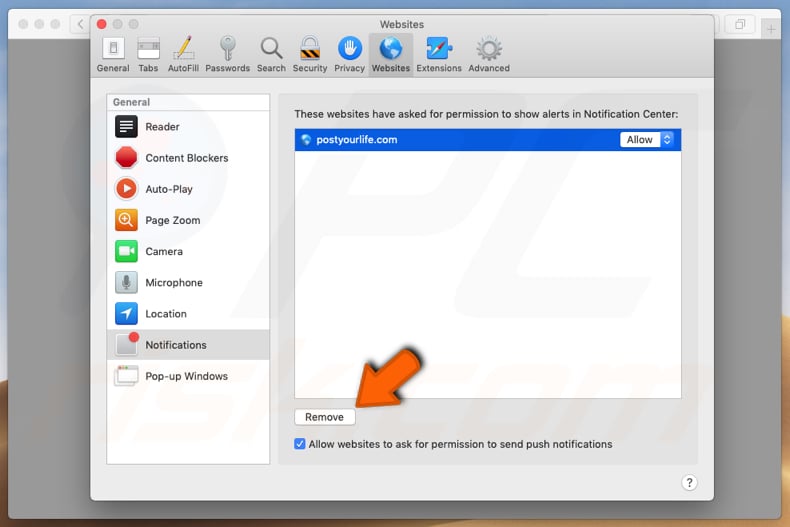
Instant automatic malware removal:
Manual threat removal might be a lengthy and complicated process that requires advanced IT skills. Combo Cleaner is a professional automatic malware removal tool that is recommended to get rid of malware. Download it by clicking the button below:
DOWNLOAD Combo CleanerBy downloading any software listed on this website you agree to our Privacy Policy and Terms of Use. To use full-featured product, you have to purchase a license for Combo Cleaner. 7 days free trial available. Combo Cleaner is owned and operated by RCS LT, the parent company of PCRisk.com.
Quick menu:
- What is You have (1) package waiting pop-up?
- How to identify a pop-up scam?
- How do pop-up scams work?
- How to remove fake pop-ups?
- How to prevent fake pop-ups?
- What to do if you fell for a pop-up scam?
How to identify a pop-up scam?
Pop-up windows with various fake messages are a common type of lures cybercriminals use. They collect sensitive personal data, trick Internet users into calling fake tech support numbers, subscribe to useless online services, invest in shady cryptocurrency schemes, etc.
While in the majority of cases these pop-ups don't infect users' devices with malware, they can cause direct monetary loss or could result in identity theft.
Cybercriminals strive to create their rogue pop-up windows to look trustworthy, however, scams typically have the following characteristics:
- Spelling mistakes and non-professional images - Closely inspect the information displayed in a pop-up. Spelling mistakes and unprofessional images could be a sign of a scam.
- Sense of urgency - Countdown timer with a couple of minutes on it, asking you to enter your personal information or subscribe to some online service.
- Statements that you won something - If you haven't participated in a lottery, online competition, etc., and you see a pop-up window stating that you won.
- Computer or mobile device scan - A pop-up window that scans your device and informs of detected issues - is undoubtedly a scam; webpages cannot perform such actions.
- Exclusivity - Pop-up windows stating that only you are given secret access to a financial scheme that can quickly make you rich.
Example of a pop-up scam:

How do pop-up scams work?
Cybercriminals and deceptive marketers usually use various advertising networks, search engine poisoning techniques, and shady websites to generate traffic to their pop-ups. Users land on their online lures after clicking on fake download buttons, using a torrent website, or simply clicking on an Internet search engine result.
Based on users' location and device information, they are presented with a scam pop-up. Lures presented in such pop-ups range from get-rich-quick schemes to fake virus scans.
How to remove fake pop-ups?
In most cases, pop-up scams do not infect users' devices with malware. If you encountered a scam pop-up, simply closing it should be enough. In some cases scam, pop-ups may be hard to close; in such cases - close your Internet browser and restart it.
In extremely rare cases, you might need to reset your Internet browser. For this, use our instructions explaining how to reset Internet browser settings.
How to prevent fake pop-ups?
To prevent seeing pop-up scams, you should visit only reputable websites. Torrent, Crack, free online movie streaming, YouTube video download, and other websites of similar reputation commonly redirect Internet users to pop-up scams.
To minimize the risk of encountering pop-up scams, you should keep your Internet browsers up-to-date and use reputable anti-malware application. For this purpose, we recommend Combo Cleaner Antivirus for Windows.
What to do if you fell for a pop-up scam?
This depends on the type of scam that you fell for. Most commonly, pop-up scams try to trick users into sending money, giving away personal information, or giving access to one's device.
- If you sent money to scammers: You should contact your financial institution and explain that you were scammed. If informed promptly, there's a chance to get your money back.
- If you gave away your personal information: You should change your passwords and enable two-factor authentication in all online services that you use. Visit Federal Trade Commission to report identity theft and get personalized recovery steps.
- If you let scammers connect to your device: You should scan your computer with reputable anti-malware (we recommend Combo Cleaner Antivirus for Windows) - cyber criminals could have planted trojans, keyloggers, and other malware, don't use your computer until removing possible threats.
- Help other Internet users: report Internet scams to Federal Trade Commission.
Frequently Asked Questions (FAQ)
What is a pop-up scam?
Pop-up scams operate by attempting to trick users into performing specific actions. For example, victims can be deceived into making monetary transactions, disclosing sensitive information, purchasing products, subscribing to services, downloading/installing software, and so forth.
What is the purpose of a pop-up scam?
Pop-up scams, like all other types, are designed to generate revenue. Scammers mainly profit by obtaining funds through deception, abusing or selling private information, promoting content, and spreading malware.
I have provided my personal information when tricked by a scam, what should I do?
If you have disclosed your log-in credentials - change the passwords of all potentially exposed accounts and inform their official support without delay. And if you've provided information of a different personal nature (e.g., ID card details, credit card numbers, etc.) - immediately change the passwords of all potentially exposed accounts.
Why do I encounter fake pop-ups?
Pop-up scams are promoted on deceptive websites. Most users enter such pages through redirects caused by mistyped URLs, sites using rogue advertising networks, spam browser notifications, intrusive advertisements, or installed adware.
Will Combo Cleaner protect me from pop-up scams?
Combo Cleaner can scan visited websites and detect rogue, deceptive, and malicious ones. This includes pages that run scams. Hence, should you enter such a webpage - you will be warned immediately, and further access to it will be restricted.
Share:

Tomas Meskauskas
Expert security researcher, professional malware analyst
I am passionate about computer security and technology. I have an experience of over 10 years working in various companies related to computer technical issue solving and Internet security. I have been working as an author and editor for pcrisk.com since 2010. Follow me on Twitter and LinkedIn to stay informed about the latest online security threats.
PCrisk security portal is brought by a company RCS LT.
Joined forces of security researchers help educate computer users about the latest online security threats. More information about the company RCS LT.
Our malware removal guides are free. However, if you want to support us you can send us a donation.
DonatePCrisk security portal is brought by a company RCS LT.
Joined forces of security researchers help educate computer users about the latest online security threats. More information about the company RCS LT.
Our malware removal guides are free. However, if you want to support us you can send us a donation.
Donate
▼ Show Discussion